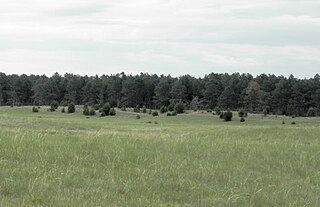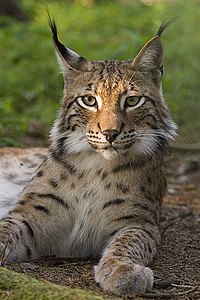
The Laurentian Mixed Forest Province, also known as the North Woods, is a forested ecoregion in eastern North America. Among others, this terminology has been adopted by the Minnesota Department of Natural Resources. Similar, though not necessarily entirely identical regions, are identified by the United States Environmental Protection Agency as Northern Lakes and Forests, and by the World Wildlife Fund by regions such as the Western Great Lakes forests and Eastern forest-boreal transition.

The Samuel R. McKelvie National Forest is a United States National Forest in the north-central Sandhills region of the U.S. state of Nebraska. The area of the national forest is 116,079 acres (181.373 sq mi). The forest is managed as part of the U.S. Forest Service's Nebraska National Forests and Grasslands, from ranger district offices in Halsey, Nebraska. The national forest is entirely within Cherry County, Nebraska.

Baba, also known by the name of its highest peak, Pelister, is a mountain in North Macedonia. The Pelister peak overlooks the city of Bitola. Baba is the third highest mountain in North Macedonia. Other peaks besides Pelister are Dva Groba, Veternica, Musa, Ržana, Široka, Kozji Kamen, Griva and Golema Čuka in North Macedonia, and Belavoda, Kirko. The Baba massif splits up the rivers in the region, so that they either flow towards the Adriatic.

Governor Dodge State Park is a 5,270-acre (2,133 ha) Wisconsin state park outside Dodgeville in Iowa County, Wisconsin. Named after Henry Dodge, the first governor of the Wisconsin Territory, the park contains geologic features indicative of the Driftless Area. It is located 4.1 miles north of the Central business district of the City of Dodgeville.

Arrowwood National Wildlife Refuge is located in the U.S. state of North Dakota. Arrowwood NWR is a part of the Arrowwood National Wildlife Refuge Complex, and is managed by the U.S. Fish and Wildlife Service. The refuge parallels 16 miles (27 km) of the James River and is a mixture of wetlands, forest and prairie. Efforts to ensure the refuge continues to provide prime nesting habitat for waterfowl include prescribed fire, haying, crop cultivation and livestock grazing. The refuge has forests with oak and hackberry which are uncommon on the prairie. It is believed that the name for the refuge is derived from Native American naming for arrow wood, as the wood in the forest was prized for the making of arrows.

Mesolouri is a mountain village and a former community in Grevena regional unit, Western Macedonia, Greece. Since the 2011 local government reform it is part of the municipality Grevena, of which it is a municipal unit. Mesolouri had 24 inhabitants as of 2021. The municipal unit has an area of 17.744 km2.

The Umatilla National Forest, in the Blue Mountains of northeast Oregon and southeast Washington, covers an area of 1.4 million acres (5,700 km2). In descending order of land area the forest is located in parts of Umatilla, Grant, Columbia, Morrow, Wallowa, Union, Garfield, Asotin, Wheeler, and Walla Walla counties. More than three-quarters of the forest lies in the state of Oregon. Forest headquarters are located in Pendleton, Oregon. There are local ranger district offices in Heppner and Ukiah in Oregon, and in Pomeroy and Walla Walla in Washington.

The North Fork Umatilla Wilderness is a wilderness area located inside the Umatilla National Forest, in the Blue Mountains of northeastern Oregon. It is the smallest wilderness in northeast Oregon, encompassing only 20,144 acres (8,152 ha) in Umatilla and Union counties.

Hidden Valley Wildlife Management Area is a 6,400-acre (26 km2) Wildlife Management Area in Washington County, Virginia, along its border with Russell County. The area is typified by mountainous mature hardwood forests that have regenerated on land logged in the early twentieth century; a number of small openings which are also maintained as habitat for local wildlife. Its elevation ranges from 2,000 to 4,000 feet above sea level. At the head of the valley is the 60-acre (24 ha) Hidden Valley Lake, which serves as the source of Brumley Creek.

The Fauna of Saskatchewan include several diverse land and aquatic animal species. From the multiplicity of invertebrates and vertebrates, two have been chosen as symbols of Saskatchewan. Cenozoic vertebrate fossils reveal the geological evolution of the interior plains and its prehistoric biogeography. Today, Saskatchewan's ecosystems range from the sub-arctic tundra of the Canadian Shield in north Saskatchewan to aspen parkland, the Mid-Continental Canadian forests in the centre of the province and grassland prairie. Fauna inhabit areas unique to their own specific and varied breeding, foraging and nesting requirements. With a large land and water area, and small population density, the ecoregions of Saskatchewan provide important habitat for many animals, both endangered and not. Naturalists observing wildlife have enumerated shrinking and growing wildlife populations. They advocate programs and methods to preserve or re-introduce endangered species and identify programs of control for outbreaks of wildlife populations. A broad diversity of wildlife habitats are preserved as parks and reserves protecting the feeding and breeding grounds of protected and indigenous fauna of Saskatchewan.

Fauna of Wales includes marine and land animals, birds and reptiles that are resident, visitors or have been introduced to Wales.

Shebenik National Park is a national park in eastern Albania adjacent to the border with North Macedonia. It encompasses 34,507.9 hectares (345.079 km2) and is specifically marked by a mountainous landscape supplied with glacial lakes, valleys, dense coniferous and deciduous forests and alpine meadows and pastures. Elevations in the park vary from 300 metres to over 2,200 metres above the Adriatic at the peak of Shebenik and Jabllanica, hence the name. It dwells a number of endangered species that are fast becoming rare in Southern Europe, including the brown bear, gray wolf and balkan lynx. The abundance in wildlife can in part be explained by the variety of vegetation types and remote location.

Mavrovo National Park is the largest of the four national parks of North Macedonia. Located in the west of the country, it spreads over an area of about 780 km2 and is characterized by deep canyons, lakes, and dense forests that abound with diverse wildlife. It was established in 1949 by a law passed by the National Assembly of Macedonia; later the legislation was changed to enforce a much stricter protection system, dividing the park into three zones: strict nature reserves, managed reserves, and a tourist zone.
Mantaritza Biosphere Reserve is situated to the north of Golyama Syutka Peak in the Rhodope Mountains in Bulgaria, and covers an area of 1319,9 hectares. The reserve was established in 1968 to protect the old coniferous forests and the biotopes of the Western capercaillie. The area was declared as biosphere reserve in 1977. It represents century-old forests of pure and mixed stands of Norway spruce (Picea abies), European birch (Fagus sylvatica) and European silver fir (Abies alba). The reserve is situated in the Bulgarian Floristic sub-region of West Rhodope within the Central European mountain biotic province. The varied fauna includes brown bear (Ursus arctos), red deer (Cervus elaphus), roe deer (Capreolus capreolus), wild boar, pine marten (Martes martes), European badger (Meles meles), hazel grouse (Bonasa bonasia), black woodpecker (Dryocopus martius) and crested tit (Parus cristatus).

Tigirekskiy Nature Reserve is a Russian 'zapovednik' in the northwest mid-level mountains of the Altai-Sayan region. The reserve was established for the protection and study of the relic pre-glacial dark taiga of the higher elevations, and the mountain-steppe of the river valleys and lower regions. The site features extensive karst landscape and caves. The reserve is situated in the Zmeinogorsky, Tretyakovsky and Krasnoshchyokovsky districts of Altai Krai. It was formally established in 1999, and covers a total area of 40,693 ha (157.12 sq mi).

Kosovo is characterised by a diverse biodiversity and an abundance of different ecosystems and habitats determined by the climate along with the geology and hydrology. Predominantly mountainous, it is located at the center of the Balkan Peninsula bounded by Montenegro to the west, Serbia to the north and east, North Macedonia to the southeast, and Albania to the southwest.

The Korab-Koritnik Nature Park is a nature park in eastern Albania and forms a section of the European Green Belt, which serves as a retreat for endangered animal and plant species. It encompasses 55,550 hectares (555.5 km2) of alpine mountainous terrain, with valleys, rivers, glacial lakes, caves, canyons and dense coniferous and deciduous forest. The International Union for Conservation of Nature (IUCN) has listed the park as Category IV. Koritnik and Korab have each been recognised as an Important Plant Area of international importance by Plantlife.

Bayuvi Dupki–Dzhindzhiritsa, also spelled Doupki–Djindjiritza, is a nature reserve in Pirin National Park, located in the homonymous mountain range in south-western Bulgaria. It is situated in Razlog Municipality, Blagoevgrad Province. Bayuvi Dupki–Dzhindzhiritsa is among the nation's oldest reserves, declared in 1934 to protect the forests of Macedonian pine and Bosnian pine, both Balkan endemic species. Its territory was further expanded in 1976 and 1980 and spans an area of 2873 ha or 28,73 km2. It was declared a UNESCO Biosphere Reserve in 1977. The reserve encompasses territory between 1200 and 2907 m altitude. Geologically it is dominated by Proterozoic marbles and has extensive karst terrain with numerous caves and karst formations.
The Pennsylvania State Game Lands Number 247 are Pennsylvania State Game Lands in Armstrong County in Pennsylvania in the United States providing hunting, bird watching, and other activities.

The wildlife of Greece includes the diverse flora, fauna, and funga of Greece, a country in southern Europe. The country is mostly mountainous with a very long, convoluted coastline, consisting of peninsulas and many islands. The climate ranges from Mediterranean through temperate to alpine, and the habitats include mountains, hills, forests, rivers, lakes, coasts and cultivated land.


















